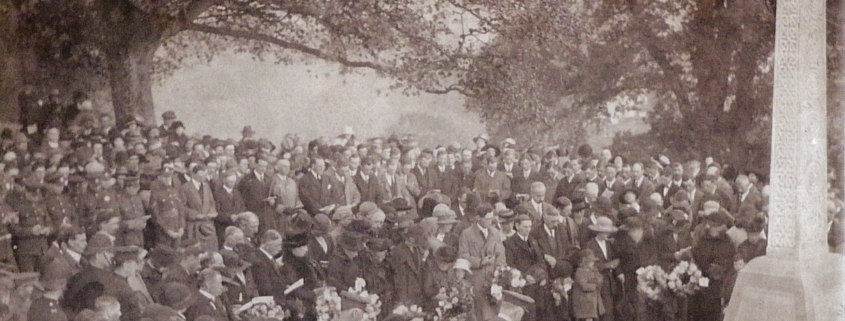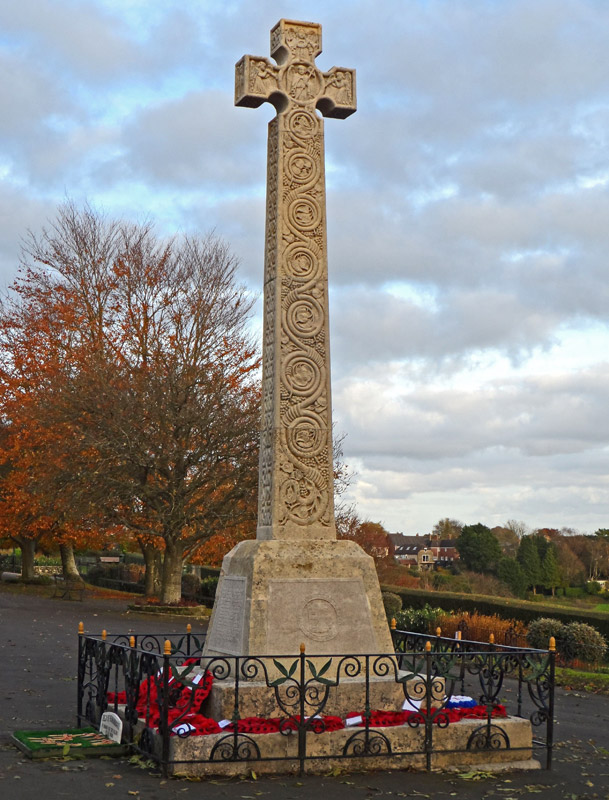Shaftesbury’s Park Walk War Memorial Unveiled One Hundred Years Ago
On Sunday afternoon 23 October 1921, as reported by the Western Gazette, “there took place one of the most impressive and soul-stirring ceremonies in the history of the borough. It was Shaftesbury’s day with the dead. Here upon the wind-swept walk, in the chilly, moist atmosphere of an October day, hundreds of townspeople honoured the memory of the 60 men who gave up their lives in the service of their King and Country.”
The following article is based on the account published in the Western Gazette of 28 October, 1921.
SHAFTESBURY’S WAR HEROES.
BEAUTIFUL EYAM CROSS UNVEILED BY EARL OF SHAFTESBURY.
STIRRING CEREMONY IN “THE PARK.”
Almost directly in front of the Westminster Memorial Hospital, there now stands this visible expression of the gratitude of a thankful people. It is a distinctive tribute, beautiful in its substantial symmetrical proportions, and in perfect harmony with the traditions of the town, itself one of the oldest in England.
The Eyam Cross in Derbyshire is the oldest of the Saxon crosses in this country, and there are few modern imitations. The only replica in the West of England is that erected at Blundell’s School, Tiverton, (by the same company of stonemasons, H. Hems of Exeter, in November 1920.) Hence Shaftesbury has a memorial of distinction.
With the exception of the four panels, which are of Hopton Wood (Derbyshire) stone, the memorial is constructed of the noted Chilmark stone, drawn from the district. The locality of the memorial gives it an added boldness and dignity, overlooking, as it does, miles and miles of country. In this unique spot stands this high tribute to the heroism and devotion to sixty gallant Shastonians, whose example will be as a beacon fire upon the hilltop, pointing the way to true greatness and noble service in the cause of humanity.
The inscription reads: ‘Lest we forget. In proud and grateful memory of the men of Shaftesbury who gave their lives in the Great War, 1914-1918’. The names of the 60 fallen are inscribed on the side panels. They are as follows:-
Walter Harry Alner. Sidney William Alner. Frederick Thomas Atkinson. William Bastable. Harry Bastable. Charles Belbin. William Belbin. Charles Blake. Charles Brickell. Frederick Brickell. James Burbidge. Harry Butt. Frederick Butt. Reginald Butt. William Thomas Cole. Charles Crew. Charles Davis. Harry Davis. Montague Durston. George Henry Dyke. Ernest Foot. Reginald Foot. Harry Gray. Sidney Gray. Edwin Greenway. Leslie Gutsell. Decimus Hardiman. Henry Meatyard Hatcher. John Highman. Walter William Hodder. Percy Hussey. Bertram Keast. Charles King. Edwin Large. Rex Lawson. Gilbert Maidment. Arthur Mayo. Frederick Miller. Frederick Morgan. Edwin George Mullins. George Newton. Sidney Parsons. Charles Parsons. Alfred Parsons. Joseph Powell. Harry Robins. Bertram Robins. Alfred Stainer. John Stainer. Frederick Taylor. Walter Thorne. Arthur Toogood. Harold Lawrence Tuffin. Hubert Frank Weldon. Reginald S White. Frank White. Leslie Reginald Wightman. Thomas Wright. Herbert Wright. Philip Sidney Young.
THE UNVEILING
A long procession left the Town Hall square shortly after 2.15pm, for a service at Holy Trinity Church. At the head walked Inspector Swain and members of the local constabulary, followed by the Comrades’ band, under bandmaster T. Wareham. The Territorials and several hundred ex-servicemen from Shaftesbury & Gillingham, under the command of Lord Stalbridge and ex Corporal-Major, T. Imber, preceded the civic body, which was led by the Mayor, wearing his robes and chain of office.
At Holy Trinity, the service was conducted by the Vicar and commenced with the hymn ‘O, God, our help’ and was followed by a pause for silent remembrance.
After the service, the procession was reformed and to the triumphant music of ‘Onward Christian soldiers’, proceeded to the memorial, which was surrounded by a huge crowd, with every point of vantage being occupied. In reserved positions, close to the memorial, were the relatives of the fallen, most of whom carried floral tributes.
After the hymn ‘Rock of ages’, the Earl of Shaftesbury addressed the crowd and then pulled the cord, releasing the flags, and revealing the beauty of the memorial. The Mayor then solemnly read the names of the fallen, and concluded, ‘May God grant that they rest in peace’. The Rector dedicated the memorial, and Lord Stalbridge laid on it the Comrades’ wreath, in national colours, bearing the inscription, ‘As a token of respect to our fallen comrades, from the ex-servicemen of Shaftesbury’. Many other wreaths were laid until the base was completely covered.
Lord Shaftesbury, although suffering from a sprained ankle, stood throughout the ceremony. Addressing the Mayor, members of the Corporation and the good people of Shaftesbury, he offered his hearty thanks for the share he was privileged to have in the impressive and stirring proceedings. Now they had unveiled the memorial to public gaze, what a host of feelings it evoked. Feelings of wonder and amazement for that supreme act of sacrifice. Then there was the thought of all the pain that that sacrifice entailed. Finally, the sense of thanksgiving and praise for the stupendous victory won. Surely they in Shaftesbury had done well in selecting this form of memorial to those of Shaftesbury who gave their lives for King and Country.
“Greater love hath no man than this,
That a man lay down his life for his friend.”
Then, after Lord Shaftesbury’s address, another hymn, prayers and a blessing, the National Anthem was sung, and a memorable and deeply stirring service ended with the sounding of the Last Post, by three members of the Cadet Corps.
The stories of most, if not all of the individuals whose names appear on local War Memorials have been researched by volunteers of the Shaftesbury Remembers Project and may be accessed by clicking here
Thanks to Peter Stanier for additional research into the construction of local War Memorials.




